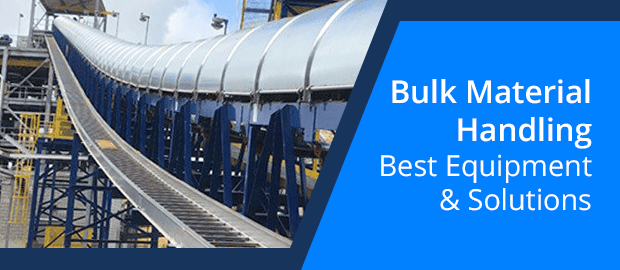The process of handling tonnes of bulk materials is challenging for most industries. There is a lot of preliminary planning that needs to be undertaken to ensure the entire process is streamlined while dealing with concerns of safety, reliability, system efficiency, and performance. Here, an efficient bulk material handling system is needed to continuously transport & supply bulk materials to units in processing plants. This will help speed up & automate the transport of bulk materials while saving you time and money. Transporting materials is the primary function of bulk material handling equipment; the secondary function is storage, mixing, blending, automation and others.
The below-detailed guide will answer all your questions related to bulk handling systems, including how it works, its benefits, and the different types of material handling equipment available.
Optimize Your Operations with Our Bulk Material Handling Solutions
A] What is Bulk Material Handling?
In bulk material handling, mechanical equipment is used to transfer bulk materials to different units and/or to store and pack bulk materials in varied boxes (octa bins), containers, rigid bins, or super sacks. Bulk material handling equipment is a vital part of all industries that process dry bulk ingredients, and some of the bulk materials that are transferred through this equipment include pellets, powders, flakes, and granules.
The bulk process equipment is handy for industries that manufacture plastics, polymers, metal, rubber, food & beverages, tobacco, cosmetic, ceramic, consumer home products, mining, paper, animal feeds, paint, mineral, pigment, metal, textile, agricultural chemicals, among others. The different types of bulk material handling systems are distinguished based on the type of application for which they are used and/or the kinds of materials they are specifically constructed to handle.
B] How Does Bulk Material Handling Systems Work?
When it comes to bulk material handling, having a planned system in place will ensure that bulk materials are transported quickly and seamlessly without any undue hassle. The process is quite simple:
- Raw materials are received to the facility via bags, drums, trucks, trains or ships.
- Upon arrival, they are unloaded using a conveyor system and stored in stockpiles or a storage facility.
- Next, to reclaim the raw materials from the stockpile, equipment such as automatic reclaimers or gravity-reclaimer or reclaimer with tunnel hoppers and feeders are used.
Once reclaimed, the raw materials are transported for processing at a facility. Here, it is important to note that for smooth transportation, the bulk material handling system needs to be customised based on your needs and environment.
C] Benefits of Using Bulk Material Handling Systems
- Reduces manual labour and costs: Since fewer workers are required to execute a given task, bulk material handling equipment helps reduce manpower, which results in reduces labour costs.
- Inventory management: This system offers greater control and accuracy, which, in turn, ensures that there is no issue with misplaced items, damages, or other unnecessary problems.
- Doubles productivity: As an automated system, bulk material handling equipment can work non-stop compared to humans. This helps maximize productivity.
- Enhance safety: Compared to manual material moving equipment, automated bulk material handling equipment helps minimize the risk of injuries, which helps enhance workers’ safety in the workplace.
Optimize Your Operations with Our Bulk Material Handling Solutions
D] Types of Bulk Material Handling Systems
1. Storage Equipment
A storage and handling equipment is used to hold or store bulk materials in between receiving and shipping materials. They are designed to utilise the vertical space in the warehouse and typically includes racks, shelves, silos, drawers, hoppers, bins, stacking frames, and mezzanines. The right storage and handling equipment can help boost production efficiency and maximize space utilisation. Also, a manufacturer may require storage equipment to safely store materials, especially during downtimes or to hold materials if they want to build up stocks.
2. Engineered Systems
Engineered system for transportation and storage of bulk material includes several types.
- Conveyor Systems: These engineered systems are available in different varieties based on the materials that need to be transported. The different types of bulk material handling conveyors include vertical conveyors, overhead conveyors, chain conveyors, vibrating conveyors, and apron conveyors.
- Automated Storage & Retrieval Systems: Accessible by a shuttle system of retrieval, these are large automated organisational engineered systems. The shuttle system can be fully automated or manually operated to find the stored item’s location and to retrieve it speedily for other uses.
- Automatic Guided Vehicles (AGV): AGVs are autonomous computer-operated robots. They are designed to transport bulk materials around a manufacturing facility and use lasers, vision, or magnets for navigation. The best part, to prevent them from colliding with anything in their predetermined path, AGVs are fitted with detectors and sensors.
- Robotic Delivery Systems: Similar to AGVs, this type of engineered system are used to transport goods throughout a warehouse or plant. It can also be used to move products on an assembly line.
3. Packing Equipment
This type of material handling equipment is often used at the end of the production process for bulk packing of materials. The packing equipment helps saves labour costs and facilitates faster filling of bulk materials in multiple containers. It also helps increase safety and boost the efficiency of the packing process. Plus, it ensures a dust-free environment making it an ideal system for swift packaging. The packing equipment is well-suited to fill boxes, drums, totes, and bulk bags.
4. Powered Industrial Trucks
One of the best examples of powered industrial trucks is Forklifts. Powered industrial trucks are vehicles or equipment that help move bulk material around the manufacturing or processing floor. This equipment can be automatic or operated manually by workers. Automated Guided Vehicles also fall in this category.
- Hand trucks: These are L-shaped devices with handles at one end, wheels at the base, and a ledge to set objects on. Hand trucks are also called dollies or box cart and simple to use.
- Side-loaders: This equipment is well-suited to load materials in a narrow aisle where the movement of a truck may be restricted. They are similar to a forklift and used to load & unload materials from the side of the machine.
- Pallet trucks: : These are industrial forklifts that slide under pallets to move them. Pallet trucks can either be manually operated or automated.
- Platform trucks: Similar to hand trucks, the only difference is that platform trucks come with an extended deck.
- Forklifts: These are operational vehicles used to load and unload heavy items from/to delivery trucks.
- Order Pickers: These vehicles are used to lift a worker off the ground, to place/remove items from higher places.
Optimize Your Operations with Our Bulk Material Handling Solutions
#How We Can Help?
Macawber Engineering has vast industry experience in providing custom equipment and handling systems for bulk materials. They are designed to withstand rugged handling in demanding conditions and known for their longevity. To design a seamless bulk material handling system we take into consideration various factors:
- Material characteristics: Bulk density, material temperature & fragility, moisture content, angle of repose, particle size distribution, and other special requirements (toxicity, corrosiveness, etc)
- Site/design specifications: Height and length of the equipment, intended capacity, spatial constraints, environmental factors, and other required accessories – service platforms, belt skirts, walkways, etc.
This helps us to design custom solutions, wherein each piece of equipment is engineered around the material that needs to be handled. We also offer after-sales support, including routine maintenance and repairs, assistance with troubleshooting, retrofits, spare parts, among others.
Contact us for more details!


